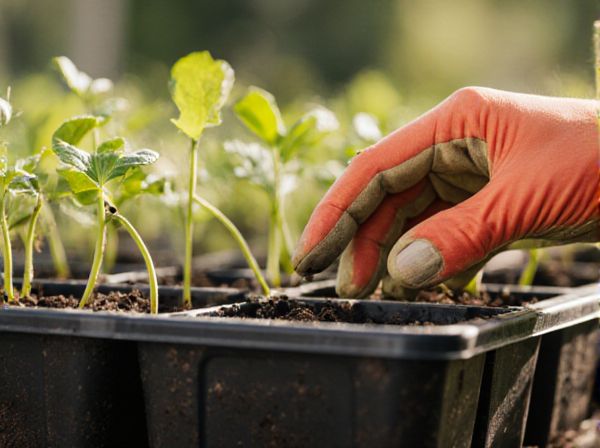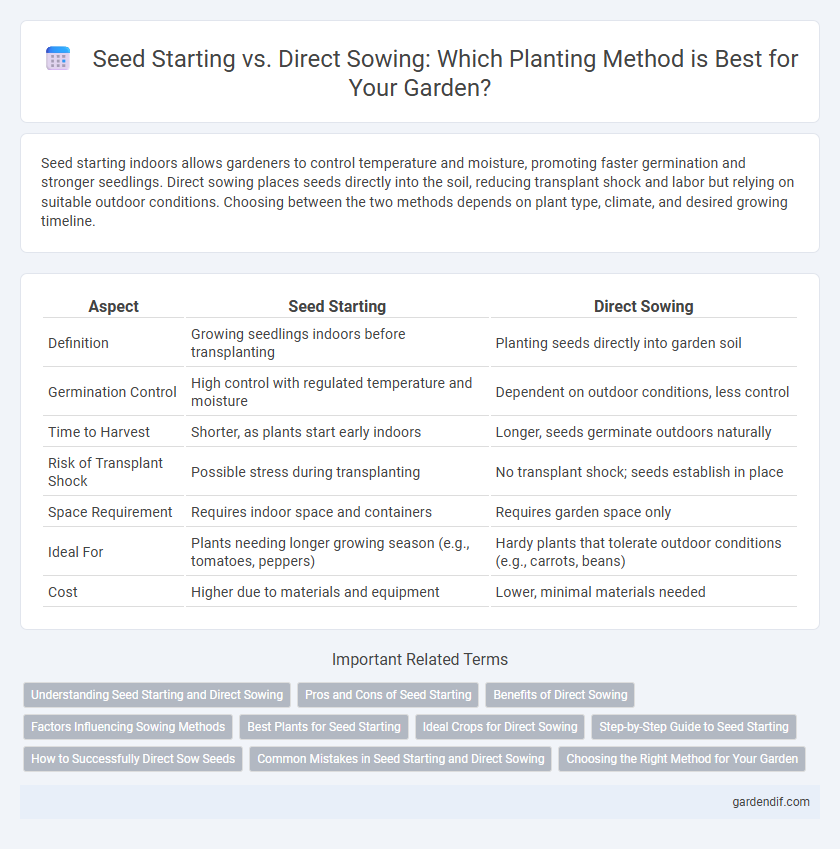
Seed Starting vs Direct Sowing Illustration
Seed starting indoors allows gardeners to control temperature and moisture, promoting faster germination and stronger seedlings. Direct sowing places seeds directly into the soil, reducing transplant shock and labor but relying on suitable outdoor conditions. Choosing between the two methods depends on plant type, climate, and desired growing timeline.
Table of Comparison
| Aspect | Seed Starting | Direct Sowing |
|---|---|---|
| Definition | Growing seedlings indoors before transplanting | Planting seeds directly into garden soil |
| Germination Control | High control with regulated temperature and moisture | Dependent on outdoor conditions, less control |
| Time to Harvest | Shorter, as plants start early indoors | Longer, seeds germinate outdoors naturally |
| Risk of Transplant Shock | Possible stress during transplanting | No transplant shock; seeds establish in place |
| Space Requirement | Requires indoor space and containers | Requires garden space only |
| Ideal For | Plants needing longer growing season (e.g., tomatoes, peppers) | Hardy plants that tolerate outdoor conditions (e.g., carrots, beans) |
| Cost | Higher due to materials and equipment | Lower, minimal materials needed |
Understanding Seed Starting and Direct Sowing
Seed starting involves germinating seeds indoors in controlled conditions to ensure optimal temperature and moisture, promoting strong seedling development before transplanting. Direct sowing places seeds directly into the soil outdoors, relying on natural environmental factors for germination, often preferred for hardy plants and easier crops like beans and carrots. Understanding the benefits and limitations of each method helps optimize plant growth cycles and improves overall garden productivity.
Pros and Cons of Seed Starting
Seed starting offers controlled conditions that enhance germination rates and extends the growing season by giving seedlings a head start indoors. It requires more time, space, and materials such as seed trays, grow lights, and soil mixes, increasing initial effort and cost. However, starting seeds indoors reduces risks from pests, weather, and soil diseases compared to direct sowing outdoors.
Benefits of Direct Sowing
Direct sowing promotes stronger root systems by allowing seeds to grow in their natural environment, reducing transplant shock and enhancing plant resilience. It saves time and labor by eliminating the need for seedling transplantation, making it ideal for large-scale gardening and farming. Furthermore, direct sowing enables better adaptation to local soil conditions and weather patterns, increasing overall germination rates and crop yields.
Factors Influencing Sowing Methods
Seed starting offers controlled environmental conditions such as temperature and moisture, which benefit plants with long germination periods or sensitivity to weather fluctuations. Direct sowing is preferable for hardy seeds that tolerate soil variations and for crops with rapid germination to reduce transplant shock. Soil type, climate, and season length critically influence the choice between seed starting and direct sowing methods.
Best Plants for Seed Starting
Seed starting offers precise control over growing conditions, making it ideal for plants like tomatoes, peppers, and eggplants that require warm soil and longer germination times. Delicate herbs such as basil and parsley also benefit from seed starting as it ensures higher germination rates and healthier seedlings. These plants thrive indoors before transplanting, providing a strong start compared to direct sowing outdoors.
Ideal Crops for Direct Sowing
Root vegetables such as carrots, radishes, and beets thrive with direct sowing due to their delicate root systems that do not transplant well. Leafy greens like spinach, arugula, and lettuce also benefit from direct sowing, allowing for faster germination and minimal disturbance. Peas and beans are ideal candidates for direct sowing as they develop strong taproots and grow efficiently when planted directly into the soil.
Step-by-Step Guide to Seed Starting
Begin seed starting by selecting high-quality seeds and using sterile seed-starting mix to ensure healthy germination. Plant seeds in trays or containers with proper depth, maintain consistent moisture, and provide adequate light using grow lights or a sunny window. Once seedlings develop true leaves and strong roots, gradually acclimate them to outdoor conditions before transplanting to the garden.
How to Successfully Direct Sow Seeds
Direct sowing seeds requires selecting high-quality, untreated seeds suited for your local climate and soil conditions, ensuring they have optimal germination rates. Proper soil preparation includes loosening the soil to a fine texture, removing weeds, and maintaining consistent moisture without waterlogging to promote seed development. Timing is critical; sow seeds when soil temperature and moisture levels align with the specific plant's needs to maximize successful sprouting and growth.
Common Mistakes in Seed Starting and Direct Sowing
Seed starting mistakes often include overwatering, insufficient light, and poor soil drainage, which lead to damping-off disease or weak seedlings. In direct sowing, common errors are planting seeds too deep, sowing at the wrong time, or failing to protect seeds from birds and pests. Proper seed depth, timing based on crop type, and adequate moisture control are essential for successful germination and healthy plant development.
Choosing the Right Method for Your Garden
Seed starting indoors allows gardeners to control temperature and light, giving seedlings a strong head start before transplanting. Direct sowing seeds into garden soil is ideal for plants with delicate roots or those that dislike transplanting, ensuring natural growth cycles are maintained. Selecting the right method depends on factors like plant species, climate, soil conditions, and the length of the growing season.
Seed Starting vs Direct Sowing Infographic

 gardendif.com
gardendif.com